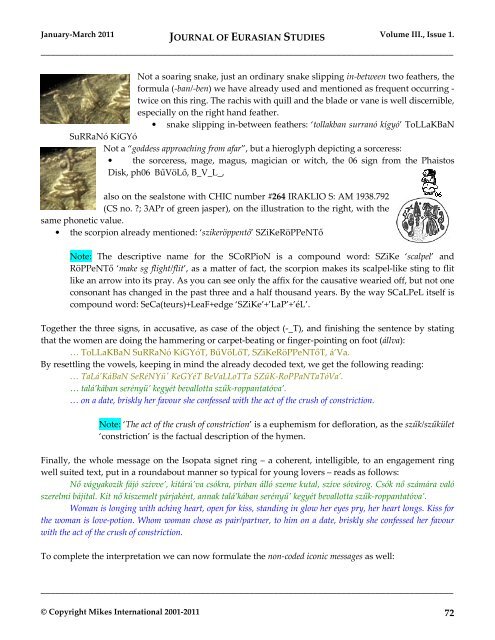JOURNAL OF EURASIAN STUDIES
JOURNAL OF EURASIAN STUDIES
JOURNAL OF EURASIAN STUDIES
Create successful ePaper yourself
Turn your PDF publications into a flip-book with our unique Google optimized e-Paper software.
January-March 2011 <strong>JOURNAL</strong> <strong>OF</strong> <strong>EURASIAN</strong> <strong>STUDIES</strong> Volume III., Issue 1.<br />
_____________________________________________________________________________________<br />
Not a soaring snake, just an ordinary snake slipping in-between two feathers, the<br />
formula (-ban/-ben) we have already used and mentioned as frequent occurring -<br />
twice on this ring. The rachis with quill and the blade or vane is well discernible,<br />
especially on the right hand feather.<br />
• snake slipping in-between feathers: ‘tollakban surranó kígyó’ ToLLaKBaN<br />
SuRRaNó KíGYó<br />
Not a “goddess approaching from afar”, but a hieroglyph depicting a sorceress:<br />
• the sorceress, mage, magus, magician or witch, the 06 sign from the Phaistos<br />
Disk, ph06 BűVöLő, B_V_L_,<br />
also on the sealstone with CHIC number #264 IRAKLIO S: AM 1938.792<br />
(CS no. ?; 3APr of green jasper), on the illustration to the right, with the<br />
same phonetic value.<br />
• the scorpion already mentioned: ‘szikeröppentő’ SZiKeRöPPeNTő<br />
Note: The descriptive name for the SCoRPioN is a compound word: SZiKe ‘scalpel’ and<br />
RöPPeNTő ‘make sg flight/flit’, as a matter of fact, the scorpion makes its scalpel-like sting to flit<br />
like an arrow into its pray. As you can see only the affix for the causative wearied off, but not one<br />
consonant has changed in the past three and a half thousand years. By the way SCaLPeL itself is<br />
compound word: SeCa(teurs)+LeaF+edge ‘SZiKe’+’LaP’+’éL’.<br />
Together the three signs, in accusative, as case of the object (-_T), and finishing the sentence by stating<br />
that the women are doing the hammering or carpet-beating or finger-pointing on foot (állva):<br />
… ToLLaKBaN SuRRaNó KíGYóT, BűVöLőT, SZiKeRöPPeNTőT, á’Va.<br />
By resettling the vowels, keeping in mind the already decoded text, we get the following reading:<br />
… TaLá’KáBaN SeRéNYü' KeGYéT BeVaLLoTTa SZűK-RoPPaNTaTóVa’.<br />
… talá’kában serényü’ kegyét bevallotta szűk-roppantatóva’.<br />
… on a date, briskly her favour she confessed with the act of the crush of constriction.<br />
Note: ‘The act of the crush of constriction’ is a euphemism for defloration, as the szűk/szűkület<br />
‘constriction’ is the factual description of the hymen.<br />
Finally, the whole message on the Isopata signet ring – a coherent, intelligible, to an engagement ring<br />
well suited text, put in a roundabout manner so typical for young lovers – reads as follows:<br />
Nő vágyakozik fájó szívve’, kitárú’va csókra, pírban álló szeme kutal, szíve sóvárog. Csók nő számára való<br />
szerelmi bájital. Kit nő kiszemelt párjaként, annak talá’kában serényű’ kegyét bevallotta szűk-roppantatóva’.<br />
Woman is longing with aching heart, open for kiss, standing in glow her eyes pry, her heart longs. Kiss for<br />
the woman is love-potion. Whom woman chose as pair/partner, to him on a date, briskly she confessed her favour<br />
with the act of the crush of constriction.<br />
To complete the interpretation we can now formulate the non-coded iconic messages as well:<br />
_____________________________________________________________________________________<br />
© Copyright Mikes International 2001-2011 72

















